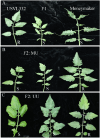Identification of a QTL region for tomato brown rugose fruit virus resistance in Solanum pimpinellifolium
- PMID: 40694064
- PMCID: PMC12283848
- DOI: 10.1007/s00122-025-04974-0
Identification of a QTL region for tomato brown rugose fruit virus resistance in Solanum pimpinellifolium
Abstract
Tomato (Solanum lycopersicum L.), one of the most widely grown vegetables in the world, has been seriously impacted in the past decade by the emerging tomato brown rugose fruit virus (ToBRFV). ToBRFV is a seed-borne tobamovirus, with ability to overcome the commonly used Tm-22 resistance gene in tomato. The objective of this study was to conduct quantitative trait locus (QTL) mapping and identify single-nucleotide polymorphism (SNP) markers associated with ToBRFV resistance in tomato. Two F2 populations were used for QTL mapping: One derived from a cross between S. pimpinellifolium USVL333 (PI 390718) × USVL332 (PI 390717) and another from 'Moneymaker' × USVL332 (PI 390717), with population sizes of 195 and 79 plants, respectively. The resistance trait was derived from the S. pimpinellifolium accession USVL332 (PI 390717). A major QTL for ToBRFV resistance was identified on chromosome 11 (SL4.0ch11), with the peak located at approximately 46.84 Mbp. This QTL spans a 22-kb interval between 46,825,788 bp and 46,847,421 bp, as determined through both genome-wide association study (GWAS) and QTL linkage mapping. Three SNP markers, SL4.0ch11_46825788, SL4.0ch11_46847421, and SL4.0ch11_46850215, demonstrated the most significant association with high LOD values (LOD = 13 in the Blink model) in GWAS analysis. In this genomic region, two disease resistance gene analogs, Solyc11g062150 (TIR-NBS-LRR resistance protein, Toll-Interleukin receptor) and Solyc11g062180 (disease resistance protein, leucine-rich repeat), were identified, which may serve as candidates for ToBRFV resistance. The QTL identified in this study could be valuable for plant breeders in facilitating tomato breeding with ToBRFV resistance.
© 2025. This is a U.S. Government work and not under copyright protection in the US; foreign copyright protection may apply.
Conflict of interest statement
Declarations. Conflict of interest: There is no conflict of interest in this research.
Figures





Similar articles
-
Tomato brown rugose fruit virus: An emerging and rapidly spreading plant RNA virus that threatens tomato production worldwide.Mol Plant Pathol. 2022 Sep;23(9):1262-1277. doi: 10.1111/mpp.13229. Epub 2022 May 22. Mol Plant Pathol. 2022. PMID: 35598295 Free PMC article. Review.
-
Evaluation of Tomato Germplasm against Tomato Brown Rugose Fruit Virus and Identification of Resistance in Solanum pimpinellifolium.Plants (Basel). 2024 Feb 21;13(5):581. doi: 10.3390/plants13050581. Plants (Basel). 2024. PMID: 38475428 Free PMC article.
-
Genomic Diversity of Tomato Brown Rugose Fruit Virus in Canadian Greenhouse Production Systems.Viruses. 2025 May 12;17(5):696. doi: 10.3390/v17050696. Viruses. 2025. PMID: 40431707 Free PMC article.
-
Identification of genetic determinants of tomato brown rugose fruit virus that enable infection of plants harbouring the Tm-22 resistance gene.Mol Plant Pathol. 2021 Nov;22(11):1347-1357. doi: 10.1111/mpp.13115. Epub 2021 Aug 13. Mol Plant Pathol. 2021. PMID: 34390124 Free PMC article.
-
Understanding tobamovirus-plant interactions: implications for breeding resistance to tomato brown rugose fruit virus.J Plant Pathol. 2023;105(1):83-94. doi: 10.1007/s42161-022-01287-9. Epub 2022 Dec 7. J Plant Pathol. 2023. PMID: 40478074 Free PMC article. Review.
References
-
- Alexander LJ (1963) Transfer of a dominant type of resistance to the four known Ohio pathogenic strains of tobacco mosaic virus (TMV) from Lycopersiconperuvianum to L. esculentum. Phytopathology 53:869
-
- Ashkenazi V, Rotem Y, Ecker R, Nashilevitz S, Barom N (2018) Tolerance in plants of Solanum lycopersicum to the tobamovirus tomato brown rugose fruit virus (TBRFV). WO Patent 2018/219941. https://patentscope.wipo.int/search/es/detail.jsf?docId=WO2018219941
-
- Bradbury PJ, Zhang Z, Kroon DE, Casstevens TM, Ramdoss Y, Buckler ES (2007) TASSEL: Software for association mapping of complex traits in diverse samples. Bioinformatics 23:2633–2635. 10.1093/bioinformatics/btm308 - PubMed
MeSH terms
Substances
Grants and funding
LinkOut - more resources
Full Text Sources
Research Materials
Miscellaneous

